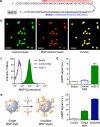Magnetic barcode assay for genetic detection of pathogens
- PMID: 23612293
- PMCID: PMC3635151
- DOI: 10.1038/ncomms2745
Magnetic barcode assay for genetic detection of pathogens
Abstract
The task of rapidly identifying patients infected with Mycobacterium tuberculosis in resource-constrained environments remains a challenge. A sensitive and robust platform that does not require bacterial isolation or culture is critical in making informed diagnostic and therapeutic decisions. Here we introduce a platform for the detection of nucleic acids based on a magnetic barcoding strategy. PCR-amplified mycobacterial genes are sequence-specifically captured on microspheres, labelled by magnetic nanoprobes and detected by nuclear magnetic resonance. All components are integrated into a single, small fluidic cartridge for streamlined on-chip operation. We use this platform to detect M. tuberculosis and identify drug-resistance strains from mechanically processed sputum samples within 2.5 h. The specificity of the assay is confirmed by detecting a panel of clinically relevant non-M. tuberculosis bacteria, and the clinical utility is demonstrated by the measurements in M. tuberculosis-positive patient specimens. Combined with portable systems, the magnetic barcode assay holds promise to become a sensitive, high-throughput and low-cost platform for point-of-care diagnostics.
Figures






Similar articles
-
Detection of Mycobacterium tuberculosis in sputum samples by polymerase chain reaction using a simplified procedure.J Clin Microbiol. 1993 Jun;31(6):1435-8. doi: 10.1128/jcm.31.6.1435-1438.1993. J Clin Microbiol. 1993. PMID: 8314982 Free PMC article.
-
Detection of Mycobacterium tuberculosis by PCR amplification with pan-Mycobacterium primers and hybridization to an M. tuberculosis-specific probe.J Clin Microbiol. 1996 Apr;34(4):918-23. doi: 10.1128/jcm.34.4.918-923.1996. J Clin Microbiol. 1996. PMID: 8815108 Free PMC article.
-
Amplification of a species-specific DNA fragment of Mycobacterium tuberculosis and its possible use in diagnosis.J Clin Microbiol. 1991 Oct;29(10):2163-8. doi: 10.1128/jcm.29.10.2163-2168.1991. J Clin Microbiol. 1991. PMID: 1939567 Free PMC article.
-
Direct detection of Mycobacterium tuberculosis in sputum by polymerase chain reaction and DNA hybridization.J Clin Microbiol. 1993 Jul;31(7):1777-82. doi: 10.1128/jcm.31.7.1777-1782.1993. J Clin Microbiol. 1993. PMID: 8349753 Free PMC article.
-
Comparison of isothermal helicase-dependent amplification and PCR for the detection of Mycobacterium tuberculosis by an electrochemical genomagnetic assay.Anal Bioanal Chem. 2016 Dec;408(30):8603-8610. doi: 10.1007/s00216-016-9514-z. Epub 2016 Apr 7. Anal Bioanal Chem. 2016. PMID: 27055885 Review.
Cited by
-
Omics Meeting Onics: Towards the Next Generation of Spectroscopic-Based Technologies in Personalized Medicine.J Pers Med. 2019 Aug 1;9(3):39. doi: 10.3390/jpm9030039. J Pers Med. 2019. PMID: 31374867 Free PMC article.
-
Magnetic ligation method for quantitative detection of microRNAs.Adv Healthc Mater. 2014 Jul;3(7):1015-9. doi: 10.1002/adhm.201300672. Epub 2014 Feb 14. Adv Healthc Mater. 2014. PMID: 24532323 Free PMC article.
-
A Comparison of Optical, Electrochemical, Magnetic, and Colorimetric Point-of-Care Biosensors for Infectious Disease Diagnosis.ACS Infect Dis. 2018 Aug 10;4(8):1162-1178. doi: 10.1021/acsinfecdis.8b00023. Epub 2018 Jun 18. ACS Infect Dis. 2018. PMID: 29860830 Free PMC article. Review.
-
Molecular phenotyping of oxidative stress in diabetes mellitus with point-of-care NMR system.NPJ Aging Mech Dis. 2020 Oct 5;6:11. doi: 10.1038/s41514-020-00049-0. eCollection 2020. NPJ Aging Mech Dis. 2020. PMID: 33083002 Free PMC article.
-
Recent Developments in Magnetic Diagnostic Systems.Chem Rev. 2015 Oct 14;115(19):10690-724. doi: 10.1021/cr500698d. Epub 2015 Aug 10. Chem Rev. 2015. PMID: 26258867 Free PMC article. Review. No abstract available.
References
-
- Kaigala GV, et al. Automated screening using microfluidic chip-based PCR and product detection to assess risk of BK virus-associated nephropathy in renal transplant recipients. Electrophoresis. 2006;27:3753–3763. - PubMed
-
- WHO . Global tuberculosis control: WHO Report. WHO; Geneva: 2012. 2012.
Publication types
MeSH terms
Substances
Grants and funding
- T32 CA079443/CA/NCI NIH HHS/United States
- R01 EB010011/EB/NIBIB NIH HHS/United States
- R01-EB010011/EB/NIBIB NIH HHS/United States
- T32 AI007638/AI/NIAID NIH HHS/United States
- DP2 OD001378/OD/NIH HHS/United States
- T32CA79443/CA/NCI NIH HHS/United States
- R01-EB00462605A1/EB/NIBIB NIH HHS/United States
- P41 EB002503/EB/NIBIB NIH HHS/United States
- R01-HL113156/HL/NHLBI NIH HHS/United States
- DP2 0D001378/DP/NCCDPHP CDC HHS/United States
- U19 AI076217/AI/NIAID NIH HHS/United States
- HHSN268201000044C/HL/NHLBI NIH HHS/United States
- R01 EB004626/EB/NIBIB NIH HHS/United States
- R01 HL113156/HL/NHLBI NIH HHS/United States
LinkOut - more resources
Full Text Sources
Other Literature Sources

